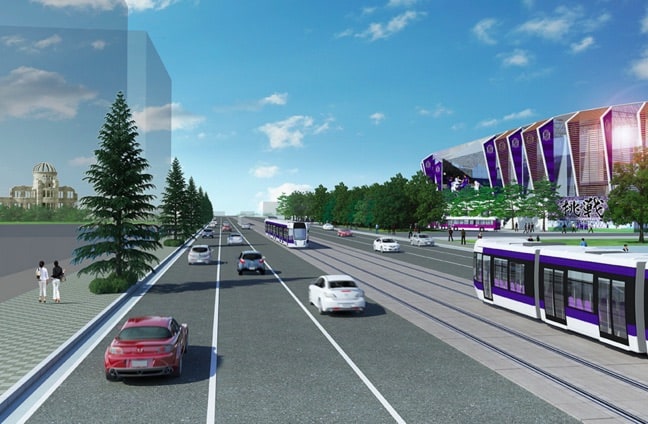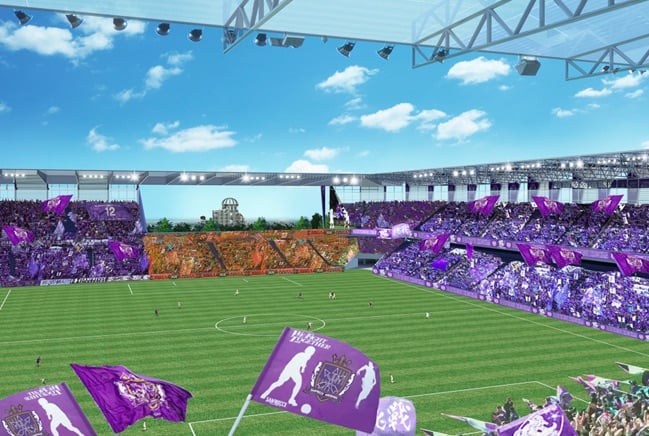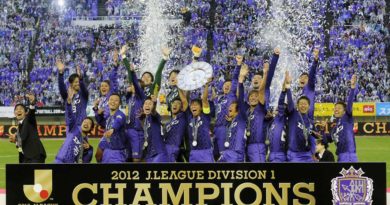Sanfrecce proposes new “Peace Stadium”
Three-time J-league champions, Sanfrecce Hiroshima, have jumped into the fray in the debate over a purpose-built, city center soccer stadium.
Calls for the team’s home ground to be moved from the cavernous Edion “Big Arch” Stadium built to host the athletics events at the 1994 Asian Games, have been growing since Sanfrecce’s J-league title wins in 2012 and 2013. Hiroshima Mayor Matsui famously got himself into hot water when, after the team failed to win a third consecutive title, he quipped that at least the agitation for a new stadium would calm down. No only was he widely derided for his lack of local pride, Sanfrecce went on to win a third league championship in 2015. Discussion over the location of a possible new stadium have centered on two locations; the former site of the Hiroshima baseball stadium across the road from the A-bomb Dome and in Hiroshima Minato Koen – the park in front of Hiroshima Port in Ujina.
Prefectural and city governments and the chamber of commerce have been leaning towards the Ujina site. However, ahead of discussions scheduled for later this month, Sanfrecce chairman and president of Edion (the club’s main sponsor), Masataka Kubo, has announced his own proposal for a “Peace Stadium” on the former baseball stadium site. The announcement was made at a press conference held on March 3rd at 3pm – a reference to the “san” in Sanfrecce and the tale of the 3 arrows associated with local Sengoku-jidai warlord Motonari Mori. In addition to a stadium design which accommodates a view of the A-bomb Dome from within, Kubo made the provocative statement that should authorities decide on the Ujina site, Sanfrecce would not use the ground.
The club summarizes its “Peace Stadium” concept as having 3 main goals.
- Development of the future of Hiroshima.
- Enhancing the promotion of Hiroshima’s message of peace.
- Development promotion of an local enduring sports culture beyond football.
Kubo’s proposed stadium would have a capacity of 25,000 as opposed to the 50,000 seater stadium favored by the Chamber of Commerce’s working group, and would cost 140 billion yen, 120 billion less than the Ujina proposal. He further stated that cash from local government would be unnecessary as he and Edion would chip in 30 billon, 35 billion would come from the Toto Sports Promotion Lottery, 20 billion from company contributions, 10 billion from individuals and 45 billion from “stadium use fees”. As the Chugoku Shinbun newspaper mentions, he made no mention of paying for the use of the site which is public land.

While I have no doubt that the former baseball stadium site would make fantastic home for Sanfrecce, would it really the best use of the site? I am no baseball fan, but I was always opposed the moving of the baseball stadium to its current location, due to the symbolic role that the Carp have had in Hiroshima since the 1950s and how it is the one place where all strata of Hiroshima society comes together. Hiroshima’s football culture is, in contrast, still very young and I wonder if it can hold the interest of the public when Sanfrecce (as it surely must) goes through a few title-less seasons.
More than that, however, I feel uncomfortable about a business owner buying up the right to use public land; Land that was taken from the Japanese military after the war to be used for the good of all the city’s people. In these times of declining and aging population, Hiroshima’s main challenge will be holding onto and attracting people, and with this in mind, quality of life will be paramount. Personally, I have yet to see a more attractive proposal for the former baseball stadium site than former mayor Akiba’s much ridiculed proposal for one of Japan’s largest urban park spaces, modeled on New York’s Central Park.
So far, alternative proposals for using the space have been disappointing and I worry that the stadium proposal will succeed for lack of imaginative alternatives.
This is of course, my personal opinion and I understand that everyone will have their own views. I would love to hear what they are in the comments below.
Links






